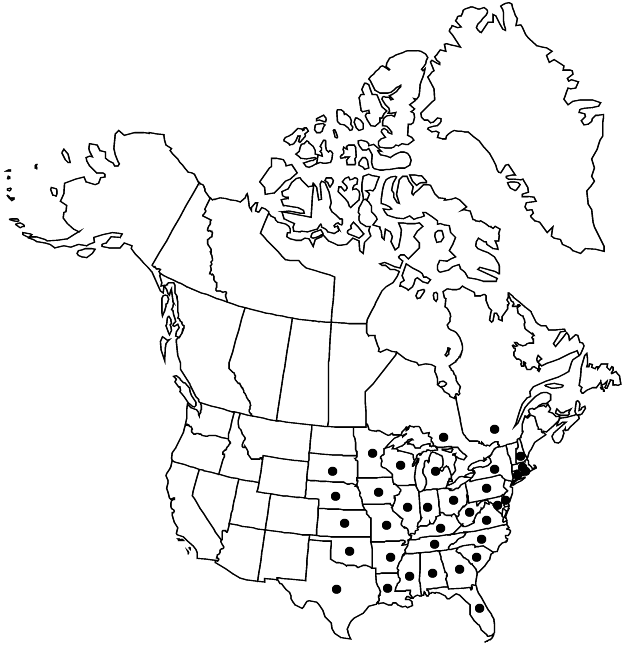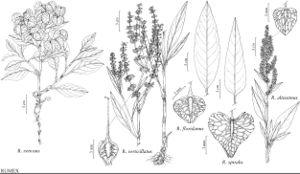Rumex verticillatus
Sp. Pl. 1: 334. 1753.
Plants perennial, glabrous or nearly so, with vertical rootstock. Stems erect or, rarely, ascending, simple or producing axillary shoots below 1st-order inflorescence or at proximal nodes, 40–100 (–150) cm. Leaf-blades with lateral-veins forming angle of 45–60° with midvein, linear-lanceolate or lanceolate, 5–30 (–40) × 1–5 cm, usually 5–7 (–10) times as long as wide, normally rather thin or at most subcoriaceous, base narrowly cuneate, margins entire, flat or slightly undulate, apex acute or acuminate. Inflorescences terminal and axillary, terminal usually occupying distal 1/3–1/2 of stem, usually lax, interrupted at least in basal 1/2, narrowly paniculate. Pedicels articulated in proximal part, distinctly thickened distally, 10–17 mm, (2.5–) 3–5 times as long as inner tepals, articulation distinctly or slightly swollen. Flowers 10–15 (–25) in remote whorls; inner tepals ovate-triangular or ovate-deltoid, 3.5–5 × 2.5–4 mm, longer than wide or, very rarely, as long as wide, base truncate or rounded, margins entire or, rarely, very indistinctly erose, apex acute or subacute (then with broadly triangular-lingulate tip); tubercles 3, equal or subequal, minutely punctate and/or transversely rugose (wrinkled) in proximal part. Achenes brown or dark-brown, 2.3–3.1 × 1.6–2.2 mm. 2n = 60.
Phenology: Flowering spring–early summer.
Habitat: Swamps, bogs, marshes, wet meadows, irrigation ditches, wet alluvial woods
Elevation: 0-800 m
Distribution

Ont., Que., Ala., Ark., Conn., Del., Fla., Ga., Ill., Ind., Iowa, Kans., Ky., La., Md., Mass., Mich., Minn., Miss., Mo., Nebr., N.J., N.Y., N.C., Ohio, Okla., Pa., R.I., S.C., S.Dak., Tenn., Tex., Vt., Va., W.Va., Wis.
Discussion
Reports of Rumex verticillatus for New Mexico (W. C. Martin and C. R. Hutchins 1980) need confirmation. The species was reported erroneously from Colorado (S. L. O’Kane et al. 1988) as a result of misidentification of R. fueginus (see W. A. Weber and R. C. Wittmann 1992).
I have not seen specimens of Rumex verticillatus from Delaware, Maine, New Hampshire, and New Jersey, but the species probably occurs in those states.
The following two species are closely related to Rumex verticillatus and sometimes treated as subspecies of it.
Selected References
None.
Lower Taxa
"/2" is not declared as a valid unit of measurement for this property."(" is not declared as a valid unit of measurement for this property.
